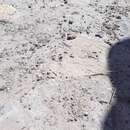Brief Summary
provided by IABIN
Diagnosis A medium-sized heavy frog, with short snout, tympanum distinct small, Å? o 1/3 of the eye diameter; nostrils terminal; skin smooth, with scattered granules; small vomerine teeth, fringes on sides of toes present; lumbar glands somewhat larger than the eye diameter;
- author
- Esteban O. Lavilla
- editor
- Diego Arrieta
Distribution
provided by IABIN
Occurs at Salta and Jujuy provinces in Argentina at the highest altitudes within the genus, and Puna from Perú (Titicaca Lake and surroundings areas, Juliaca, Puno, Ilave) and Bolivia (Cochabamba, Chuquisaca, La Paz, Oruro, Potosí, and Santa Cruz Departments).
- author
- Esteban O. Lavilla
- editor
- Diego Arrieta
Diagnostic Description
provided by IABIN
Adult morphology Snout-vent of about 35-45 mm: males smaller than females. Head wider than larger; snout short, truncate, with terminal nostrils, antero-laterally located. Interocular distance narrower than the internarinal interval and the upper eyelid. Canthus rostralis rounded; lored slightIy concave, sloping up to the upper lip. Maxillary teeth present; vomerine teeth in two weak oblique patches between the choanae. Eye prominent, antero-laterally located. Tongue elliptical, slightly notched behind. Tympanum distinct, about Å? of the eye diameter or less. Supratympanic ridge moderate, reaching the axial. Fingers blunt, slightly fringed; rate of the finger lengths: IV-II-I-III. Metacarpal tubvercles well-developed, rounded; subarticular tubercles blunt and distinct. Toes almost unwebbed, with sharp, conical subarticular tubercles. Metatarsal tubercles shovel-shaped and prominent. No tarsal fold distinct. When hindleg is adpressed, heel reaches the eye; when the femurs are bent at right ankles of the body the tibio-tarsal articulations slightly overlap. Skin smooth, scantly glandular on the dorsum. Loose gular folds and a single vocal sac in males. A bulky elliptical lumbar gland, slightly larger than the eye diameter. Belly minutely granular; lower surface of thighs coarsely granular. Discoidal fold present. Dark nuptial pads in males. Coloration: Dorsally brownish, with enlarged longitudinal dark spots, speckled with black and encircling the flat glandular patches. A W-shaped dark glandular ridge behind the eyes. A bright black central spot on the light ground color of te lumbar glands. Groin and thighs yellow. Belly white. Larval morphology With oval, slightly depressed dark body and relatively short tail with high transparent fins, speckled with dark. The inerocular distance is larger than the internarinal interval, and smaller than the mouth. Caudal musculature extends dorsally into the body; the spiracle is sinistral, latero-dorsally located; the anal tube opening medially. Tooth rows formula: 2(2)/ 3 . Only a broad single raw of marginal papillae is present.
- author
- Esteban O. Lavilla
- editor
- Diego Arrieta
Conservation Status
provided by IABIN
LC. Least Concern.
- author
- Esteban O. Lavilla
- editor
- Diego Arrieta
Comprehensive Description
provided by Smithsonian Contributions to Zoology
Pleurodema cinerea
There are two lingual papillae. There is a moderately large number of buccal floor papillae arranged in a posteriorly directed “V” (Figure 56d). The nares are obliquely oriented. The median ridge is small. The lateral-ridge papillae are very large with finger-like processes.
None of the characters in the above suite is particularly diagnostic. In terms of overall branchial basket structure, P. cinerea is most similar to Atelognathus, Eupsophus, Hylodes, Hylorina, Leptodactylus, and Odontophrynus. Leptodactylus larvae have less buccal papillation than P. cinerea. Hylodes has more extensive papillation on the buccal roof and dorsal and ventral vela, and has a more flattened branchial basket. The lateral-ridge papillae of cinerea are simpler than in the other genera with similar branchial-basket structure.
The larval features are those found in other typical pond larvae. The larvae occur in temporary rain pools; the eggs are laid in a foam nest (Cei, 1980:362).
- bibliographic citation
- Wassersug, Richard J. and Heyer, W. Ronald. 1988. "A survey of internal oral features of Leptodactyloid larvae (Amphibia: Anura)." Smithsonian Contributions to Zoology. 1-99. https://doi.org/10.5479/si.00810282.457
Comprehensive Description
provided by Smithsonian Contributions to Zoology
Pleurodema cinerea Cope
MATERIAL.—KU 164009 (3 specimens dissected, stages 31, 32, 33, SVLs 21.0, 20.6, 23.9 mm respectively; stage 32 specimen illustrated). Collected from 4 km W Santa Rosa, 4010 m, Puno, Peru.
REFERENCE.—Cei (1980) described and illustrated the larva.
GENERAL
- bibliographic citation
- Wassersug, Richard J. and Heyer, W. Ronald. 1988. "A survey of internal oral features of Leptodactyloid larvae (Amphibia: Anura)." Smithsonian Contributions to Zoology. 1-99. https://doi.org/10.5479/si.00810282.457
Pleurodema cinereum
provided by wikipedia EN
- license
- cc-by-sa-3.0
- copyright
- Wikipedia authors and editors
Pleurodema cinereum: Brief Summary
provided by wikipedia EN
Pleurodema cinereum is a species of frog in the family Leptodactylidae. It is found in the Andes in northwestern Argentina, Bolivia, and southeastern Peru. Its common name is Juliaca four-eyed frog, after its type locality, Juliaca. Pleurodema borellii is possibly a junior synonym of this species.
Its natural habitats are open montane puna grasslands and semi-deciduous forests. Reproduction takes place in small permanent and temporary pools where pairs build floating foam nests. It is a common species facing no major threats.
- license
- cc-by-sa-3.0
- copyright
- Wikipedia authors and editors

